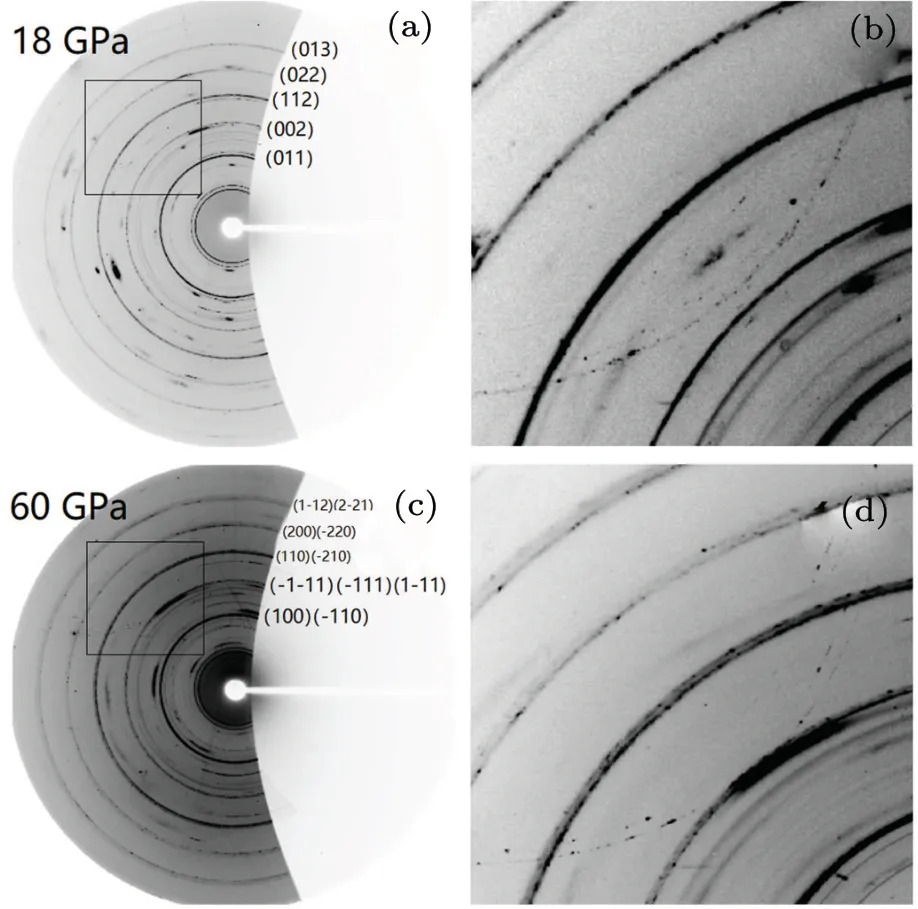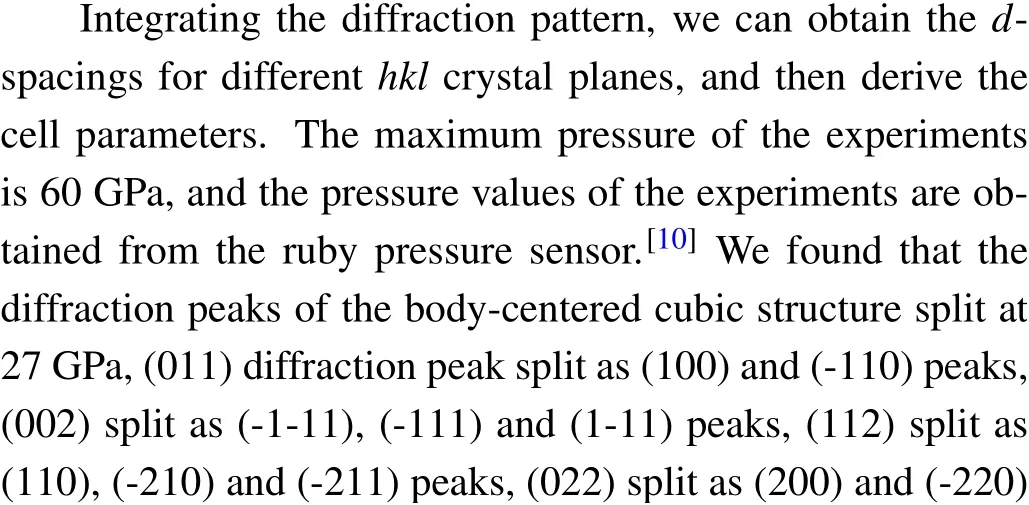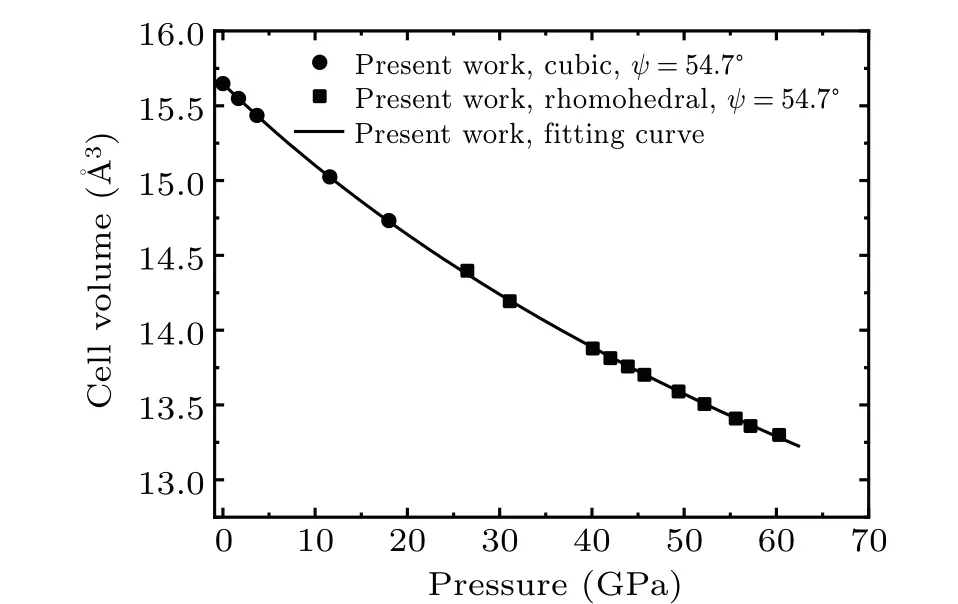Equal compressibility structural phase transition of molybdenum at high pressure
2022-11-21LunXiong熊伦BinLi李斌FangMiao苗芳QiangLi李强GuangpingChen陈光平JinxiaZhu竹锦霞YingchunDing丁迎春andDuanweiHe贺端威
Lun Xiong(熊伦) Bin Li(李斌) Fang Miao(苗芳) Qiang Li(李强) Guangping Chen(陈光平)Jinxia Zhu(竹锦霞) Yingchun Ding(丁迎春) and Duanwei He(贺端威)
1School of Intelligent Manufacturing,Sichuan University of Arts and Science,Dazhou 635000,China
2DaZhou Industrial Technology Institute of Intelligent Manufacturing,Dazhou 635000,China
3College of Optoelectronics Engineering,Chengdu University of Information Technology,Chengdu 610225,China
4Institute of Atomic and Molecular Physics,Sichuan University,Chengdu 610065,China
5Key Laboratory of High Energy Density Physics and Technology of Ministry of Education,Sichuan University,Chengdu 610065,China
We have studied the high-pressure compression behavior of molybdenum up to 60 GPa by synchrotron radial x-ray diffraction(RXRD)in a diamond anvil cell(DAC).It is found that all diffraction peaks of molybdenum undergo a split at around 27 GPa,and we believe that a phase transition from a body-centered cubic structure to a rhombohedral structure at room pressure has occurred. The slope of pressure–volume curve shows continuity before and after this phase transition,when fitting the pressure–volume curves of the body-centered cubic structure at low pressure and the rhombohedral structure at high pressure. A bulk modulus of 261.3 (2.7) GPa and a first-order derivative of the bulk modulus of 4.15 (0.14) are obtained by using the nonhydrostatic compression data at the angle ψ =54.7° between the diffracting plane normal and stress axis.
Keywords: molybdenum,high pressure,phase transition,radial x-ray diffraction,diamond anvil cell
Transition metal molybdenum is a common pressure scale used in high-pressure physics,and its equation of state(EOS)is widely used for pressure calibration in diamond anvil cell(DAC) experiments. However, since the 1990s, experimental and theoretical calculations have found that the possible phase transition of molybdenum at high pressures has been controversial. Therefore, studying the phase transition of molybdenum at high pressures can contribute to a better understanding of the high-pressure physical properties of d-electron transition metals.
Hixsonet al.[1]experimentally measured the Hugoniot sound velocity of molybdenum and found an inflection near 210 GPa pressure, suggesting that the solid-solid phase transition of molybdenum occurred before the impact melting, but the subsequent results of static and high pressure experiments[2,3]did not support this assertion. Meanwhile, Moriarty[4]and Boettgeret al.[5]and Belonoshkoet al.[6]computationally studied the phase stability of the bodycentered cubic(bcc),face-centered cubic(fcc),and dense-row hexagonal (hcp) structures of molybdenum based on the first principles,and their results did not support a phase transition near 210 GPa. Cazorlaet al.[7]performed calculations after considering anharmonic effects and showed that the fcc and hcp high-temperature phases of molybdenum are not more stable than the bcc phase in the range of 0–600 GPa. Wanget al.[8]explored the high-pressure stable structure of molybdenum based on a particle swarm optimization algorithm and predicted the bcc→dhcp phase transition at 660 GPa at zero temperature. Zhaoet al.[9]used the generalized gradient approximation(GGA)to calculate the total energy and enthalpy of molybdenum at different volumes for body-centered cubic (bcc) and double-layer dense hexagonal (dhcp) structures within the framework of the DFT of the plane wave pseudopotential, and the calculated isothermal compression lines were in good agreement with the previous calculations. The phase transition of the structure bcc→dhcp near 620 GPa pressure is predicted by making a difference in the enthalpy values.Based on the results of the phonon spectra,it can be seen that the bcc structure may change to the dhcp or 9R structure at high pressure. The calculation of the mechanical stability further shows that dhcp-Mo is a stable phase at 620 GPa.
In order to investigate the presence of phase transition metal molybdenum at high pressure, we studied it in a DAC with synchrotron radial x-ray diffraction(RXRD)up to 60 GPa. In order to clarify the structure after the phase transition,we searched for some possible structures by theoretical calculations using the density functional theory(DFT).
The crystal structure of molybdenum at room temperature and room pressure is a body-centered cubic structure. The space group isIm-3m. The molybdenum samples for highpressure RXRD experiments were purchased from Alfa Aesar (99.9% purity) and have cell parameters ofa=b=c=5.5942(0.0021) ˚A andα=β=γ=90°,respectively.We performed RXRD experiments using a two-fold panoramic DAC with a culet diameter of 300 μm to study the compression behavior of molybdenum under differential stress compression.A beryllium(Be)gasket was firstly precompressed to approximately 20 GPa,at which pressure the thickness was~25 μm.A 60 μm diameter hole was then drilled in the middle of the indentation. A ruby chip of~10 μm diameter was placed at the center above the sample chip as the pressure standard.[10]In order to generate a large differential stress,we did not add a pressure transmission medium. The DAC was tilted to an angle of 28°to minimize the effect of the diffraction peaks of the Be gasket on the diffraction signal of the sample.
Thein situhigh-pressure RXRD experiments were conducted at the Beijing Synchrotron Radiation Facility (BSRF)4W2 beam line.The wavelength of synchrotron radiation used at the beam line is 0.6199 ˚A.The spot size after focusing with a Kirkpatrick–Baez mirror is 30 μm×8 μm (FWHM). The powder diffraction signal (Fig. 1) was received by a Mar345 detector and integrated with Fit2D software[11](Fig. 2). The diffraction spectra for each pressure were collected for 20 minutes after 30 minutes stress relaxation.

Fig. 1. (a) The diffraction pattern of molybdenum recorded on an image plate at 18 GPa under nonhydrostatc compression. The index based on a bcc lattice. (b)The enlarged image of the square area in(a). The diffraction pattern of molybdenum at 60 GPa. The index based on a rhombohedral lattice. (d)The enlarged image of the square area in(c).



Fig.2. (a)Nonhydrostatic RXRD patterns of molybdenum at 12 GPa,56 GPa and 5 GPa(decompression). The insets are cubic and rhombohedral structures,respectively.(b)The RXRD patterns at pressures near 27 GPa with phase transition of 18 GPa,27 GPa and 31 GPa.
The enlarged diffraction images of(002)and(112)at different pressures are shown in Fig.3. It can be seen that at low pressures, the diffraction peaks of molybdenum are always single peaks and no split occurs. At high pressures,the splitting occurs,and the diffraction peak remains split after decompression to low pressure. Conventional axial x-ray diffraction(XRD) is on the minimum stress direction (ψ=90°), when the stress is less than the hydrostaticψ=54.7°direction.[13]The result is that the compression curve observed by conventional XRD is distinguished from the compression curve at hydrostatic pressure. We used RXRD to study the compression behavior of molybdenum at high pressure and found a structural phase transition from body-centered cubic to rhombohedral(all diffraction peaks appear splits),but no structural phase transition was found in the previous axial XRD experiments,possibly because the differential stress of axial XRD is not sufficient or RXRD can observe diffraction spectra in the direction of larger differential stress. In the past,although the axial diffraction pressure was as high as one hundred of GPa,the ratio of differential stress to confining pressure (ambient pressure or average pressure)was low because of the pressure transmission medium. Therefore, no such structural phase transition was observed. There are many similar phenomena.For example, hBN can be transformed into wBN under the action of shear stress (rotational diamond anvil cell, RDAC)under the confining pressure of about 6.7 GPa. However,conventional DAC experiments may not be able to observe such a structural phase transition up to 52.8 GPa.[14]In addition to the increase of pressure, the high deviatoric stress will also produce additional thermodynamic driving force, which makes the possibility of lattice reconstruction to high-pressure phase and additional atomic transformation path.[14]

Fig.3. Enlarged views of diffraction peaks of(002)and(112)at different positions of diffraction images at different pressures.
The normalized compression curve forψ= 54.7°are shown in Fig. 4. We fitted the body-centered cubic structure and the rhombohedral structure before and after 27 GPa,respectively. The derived bulk modulus is 260.6 (0.9) GPa and 260.4 (3.8) GPa, respectively. From Fig. 4, it can be seen that the volumes of the rhombohedral structure and the volume of the body-centered cube are continuous at different pressures, indicating that the phase transition may be related to the softening of theC44triangular elastic tensor,which originates from a combination of Fermi surface nesting,band Jahn–Teller distortion and electronic topological transition combination.[15]Fitting both the body-centered cubic structure data and the rhombohedral structure data, we obtained a bulk modulus of 261.3 (2.7) GPa with its first-order derivative as 4.15(0.14).

Fig.4. Pressure–volume compression curve for molybdenum. The line represents the results of fitting by the third-order Birch–Murnaghan EOS for both body-centered cubic structure and the rhombohedral structure.
In summary, we have studied the compression behavior of molybdenum to 60 GPa in a nonhydrostatic environment in a diamond anvil cell using RXRD. We found that the all of the diffraction peaks of molybdenum split at 27 GPa, and we believed that molybdenum undergoes a structural phase transition from a body-centered cubic structure to a rhombohedral structure. DFT calculations revealed that the rhombohedral structure is most stable structure at high pressures. The transition could be associated with a soft-mode phonon inducedC44instability that originates from the Fermi surface nesting, band Jahn–Teller distortion and electronic topological transition combination. We fitted the pressure-volume data of both of the body-centered cubic structure and the rhombohedral structure to obtain their bulk modulus and its first-order derivative as 261.3(2.7)GPa and 4.15(0.14),respectively.
Acknowledgements
Project supported by the National Natural Science Foundation of China(Grant No.12075163),the Open fund project of Industrial Technology Institute of Sichuan University of Arts and Science, China (Grant No. ZNZZ2101) and the Project of Ph. D special research of Sichuan University of Arts and Science, China (Grant No. 2019BS006Z). The synchrotron radiation RXRD experiments in this work were performed at 4W2 beamline of Beijing Synchrotron Radiation Facility(BSRF),which is supported by the Chinese Academy of Sciences(Grant Nos.KJCX2-SW-N03 and KJCX2-SW-N20).
猜你喜欢
杂志排行
Chinese Physics B的其它文章
- A design of resonant cavity with an improved coupling-adjusting mechanism for the W-band EPR spectrometer
- Photoreflectance system based on vacuum ultraviolet laser at 177.3 nm
- Topological photonic states in gyromagnetic photonic crystals:Physics,properties,and applications
- Structure of continuous matrix product operator for transverse field Ising model: An analytic and numerical study
- Riemann–Hilbert approach and N double-pole solutions for a nonlinear Schr¨odinger-type equation
- Diffusion dynamics in branched spherical structure
